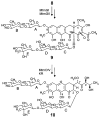Ketopremithramycins and ketomithramycins, four new aureolic acid-type compounds obtained upon inactivation of two genes involved in the biosynthesis of the deoxysugar moieties of the antitumor drug mithramycin by Streptomyces argillaceus, reveal novel insights into post-PKS tailoring steps of the mithramycin biosynthetic pathway
- PMID: 11853433
- PMCID: PMC4480631
- DOI: 10.1021/ja0105156
Ketopremithramycins and ketomithramycins, four new aureolic acid-type compounds obtained upon inactivation of two genes involved in the biosynthesis of the deoxysugar moieties of the antitumor drug mithramycin by Streptomyces argillaceus, reveal novel insights into post-PKS tailoring steps of the mithramycin biosynthetic pathway
Abstract
Mithramycin is an aureolic acid-type antimicrobial and antitumor agent produced by Streptomyces argillaceus. Modifying post-polyketide synthase (PKS) tailoring enzymes involved in the production of mithramycin is an effective way of gaining further information regarding the late steps of its biosynthetic pathway. In addition, new "unnatural" natural products of the aureolic acid-type class are likely to be produced. The role of two such post-PKS tailoring enzymes, encoded by mtmC and mtmTIII, was investigated, and four novel aureolic acid class drugs, two premithramycin-type molecules and two mithramycin derivatives, were isolated from mutant strains constructed by insertional gene inactivation of either of these two genes. From data bank comparisons, the corresponding proteins MtmC and MtmTIII were believed to act as a C-methyltransferase involved in the production of the D-mycarose (sugar E) of mithramycin and as a ketoreductase seemingly involved in the biosynthesis of the mithramycin aglycon, respectively. However, gene inactivation and analysis of the accumulated products revealed that both genes encode enzymes participating in the biosynthesis of the D-mycarose building block. Furthermore, the inactivation of MtmC seems to affect the ketoreductase responsible for 4-ketoreduction of sugar C, a D-olivose. Instead of obtaining premithramycin and mithramycin derivatives with a modified E-sugar upon inactivation of mtmC, compounds were obtained that completely lack the E-sugar moiety and that possess an unexpected 4-ketosugar moiety instead of the D-olivose at the beginning of the lower deoxysaccharide chain. The inactivation of mtmTIII led to the accumulation of 4E-ketomithramycin, showing that this ketoreductase is responsible for the 4-ketoreduction of the D-mycarose moiety. The new compounds of the mutant strains, 4A-ketopremithramycin A2, 4A-keto-9-demethylpremithramycin A2, 4C-keto-demycarosylmithramycin, and 4E-ketomithramycin, indicate surprising substrate flexibility of post-PKS enzymes of the mithramycin biosynthetic pathway. Although the glycosyltransferase responsible for the attachment of D-mycarose cannot transfer the unmethylated sugar to the existing lower disaccharide chain, it can transfer the 4-ketoform of sugar E. In addition, the glycosyltransferase MtmGIV, which is responsible for the linkage of sugar C, is also able to transfer an activated 4-ketosugar. The oxygenase MtmOIV, normally responsible for the oxidative cleavage of the tetracyclic premithramycin B into the tricyclic immediate precursor of mithramycin, can act on a substrate analogue with a modified or even incomplete trisaccharide chain. The same is true for glycosyltransferases MtmGI and MtmGII, both of which partake in the formation and attachment of the A-B disaccharide in mithramycin.
Figures





Similar articles
-
Oxidative cleavage of premithramycin B is one of the last steps in the biosynthesis of the antitumor drug mithramycin.Chem Biol. 1999 Jan;6(1):19-30. doi: 10.1016/s1074-5521(99)80017-9. Chem Biol. 1999. PMID: 9889148
-
Identification of two genes from Streptomyces argillaceus encoding glycosyltransferases involved in transfer of a disaccharide during biosynthesis of the antitumor drug mithramycin.J Bacteriol. 1998 Sep;180(18):4929-37. doi: 10.1128/JB.180.18.4929-4937.1998. J Bacteriol. 1998. PMID: 9733697 Free PMC article.
-
The mtmVUC genes of the mithramycin gene cluster in Streptomyces argillaceus are involved in the biosynthesis of the sugar moieties.Mol Gen Genet. 2001 Feb;264(6):827-35. doi: 10.1007/s004380000372. Mol Gen Genet. 2001. PMID: 11254130
-
The aureolic acid family of antitumor compounds: structure, mode of action, biosynthesis, and novel derivatives.Appl Microbiol Biotechnol. 2006 Nov;73(1):1-14. doi: 10.1007/s00253-006-0511-6. Epub 2006 Sep 30. Appl Microbiol Biotechnol. 2006. PMID: 17013601 Review.
-
Expanding the Chemical Diversity of the Antitumoral Compound Mithramycin by Combinatorial Biosynthesis and Biocatalysis: The Quest for Mithralogs with Improved Therapeutic Window.Planta Med. 2015 Oct;81(15):1326-38. doi: 10.1055/s-0035-1557876. Epub 2015 Sep 21. Planta Med. 2015. PMID: 26393942 Review.
Cited by
-
Ketoolivosyl-tetracenomycin C: a new ketosugar bearing tetracenomycin reveals new insight into the substrate flexibility of glycosyltransferase ElmGT.Bioorg Med Chem Lett. 2012 Mar 15;22(6):2247-50. doi: 10.1016/j.bmcl.2012.01.094. Epub 2012 Feb 3. Bioorg Med Chem Lett. 2012. PMID: 22361136 Free PMC article.
-
Natural-product sugar biosynthesis and enzymatic glycodiversification.Angew Chem Int Ed Engl. 2008;47(51):9814-59. doi: 10.1002/anie.200801204. Angew Chem Int Ed Engl. 2008. PMID: 19058170 Free PMC article. Review.
-
Inhibition of Sp1-dependent transcription and antitumor activity of the new aureolic acid analogues mithramycin SDK and SK in human ovarian cancer xenografts.Gynecol Oncol. 2010 Aug 1;118(2):182-8. doi: 10.1016/j.ygyno.2010.03.020. Epub 2010 May 8. Gynecol Oncol. 2010. PMID: 20452660 Free PMC article.
-
Novel GC-rich DNA-binding compound produced by a genetically engineered mutant of the mithramycin producer Streptomyces argillaceus exhibits improved transcriptional repressor activity: implications for cancer therapy.Nucleic Acids Res. 2006 Mar 29;34(6):1721-34. doi: 10.1093/nar/gkl063. Print 2006. Nucleic Acids Res. 2006. PMID: 16571899 Free PMC article.
-
Nanoparticulate formulations of mithramycin analogs for enhanced cytotoxicity.Int J Nanomedicine. 2011;6:2757-67. doi: 10.2147/IJN.S25427. Epub 2011 Nov 8. Int J Nanomedicine. 2011. PMID: 22114504 Free PMC article.
References
-
- Skarbek JD, Speedie MK. Antitumor Antibiotics of the Aureolic Acid Group: Chromomycin A3, Mithramycin A, and Olivomycin A. In: Aszalos A, editor. Antitumor Compounds of Natural Origin. Vol. 1. CRC Press; Boca Raton, FL: 1981. pp. 191–235.
-
- Van Dyke MW, Dervan PB. Biochemistry. 1983;22:2373–2377. - PubMed
-
- Remers WA. The Chemistry of Antitumor Antibiotics. Vol. 1. Wiley-Inter-science; New York: 1979. pp. 133–175.
-
- Rohr J, Méndez C, Salas JA. Bioorg Chem. 1999;27:41–54.
Publication types
MeSH terms
Substances
Grants and funding
LinkOut - more resources
Full Text Sources
Other Literature Sources
Molecular Biology Databases
Miscellaneous

